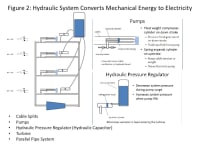This invention channels wave energy through float weights, cables, hydraulics and a generator into electricity for public use.
{Diagram 1}
Float weights* move up and down on the surface of water with each wave. The up and down motion of the float weights are transmitted into linear cable motion. This motion is further redirected though pumps into pressure surges within a closed hydraulic system.
*These float weights large diameter plastic ellipsoids filled with water. They are slightly buoyant.
{Diagram 2}
A hydraulic pressure storage mechanism regulates the pressure surges into a more constant pressure surge elevation for delivery through the turbine.
Most mechanical or failure prone parts are on land. Only weights, cables, cable housing, and sea based supports have contact with the sea or sea spray. The hydraulic components are almost modular for easy replacement.
Since many successive water weights can be placed placed in a row, most the potential energy of a wave can be converted to electricity - or at least as much as is economically practical. (more water weights mean more pumps, wave height diminishes with each successive water weight)
Limits:
Installation sites must be selected for sufficient and consistent wave magnitudes. The weights and cable housing must be located past where waves break.
Considerations:
Several of these systems should be installed in parallel along the coast so they can use a single turbine. Mechanical alternatives to the hydraulic system are possible, but difficult to design as they must take into account varying wave frequency and magnitude.
Installation: I imagine the installation cost may be somewhat tricky. I imagine large hydraulic cement blocks could be placed. If these blocks contain threaded inserts, the support rods may be able to thread in without many additional sea based components. The cable housing fits on top of these rods.
Comparable Products:
Comparable designs use wave pressure elevations to channel air through a turbine or to generate electricity on board buoys, or use buoys to direct high pressure fluids to the shore. The proposed product uses cables to redirect motion to the shore and thus has an advantage of simple repair, potential robustness, and some modularity at some cost of added installation complexity. This design is excellent in that the costly components are on shore and protected.
Like this entry?
-
About the Entrant
- Name:Samuel Prager
- Type of entry:individual
- Software used for this entry:ppt, openoffice equivalent
- Patent status:none





